You don’t get a nickname like Bat City for nothing. Don’t believe us? Just take a field trip to the Congress Avenue Bridge. There’s no need to wing it, though — we did a little research about the creature’s history in Austin before you hit the road.
Bats are really cool

Mexican Free-Tailed Bats are tiny, but they can live as long as 18 years. | Photo by the U.S. Fish and Wildlife Service Headquarters via Wikimedia Commons
Austin’s roost of Mexican Free-Tailed Bats is estimated to make up the largest urban bat colony in the world. (The world’s largest non-urban bat colony is in San Antonio’s Bracken Cave, which contains more than 15 million bats.)
And these bats are pretty amazing. For one, they’re tiny — between 0.4 to 0.5 ounces — but they can live as long as 18 years. With flight speeds up to 60 mph, they’re also considered the “jets” of the bat world.
The winged creatures also act as pest control, with Austin’s colony eating between 10,000-30,000 pounds of insects each night.
Chowing down on food is particularly important for the bats right now, as the Congress Avenue roost primarily consists of pregnant females. Starting next month, there’s going to be a real bat baby boom in Downtown Austin as all of the pups are born, and by fall, as many as 1.5 million bats will be taking flight from the bridge every night.
(Another fun fact: In some roosts, the density of baby bats can be as high as 500 pups per square foot.)
Austinites didn’t always embrace the bats
Bats have been in the city since before Austin was Austin, but for years, they were considered pests. Locals know bats will roost in all kinds of human structures: construction sites, attics, abandoned buildings... bridges.
When the Congress Avenue Bridge was renovated in 1980, it made the perfect haven for migrating Mexican Free-Tailed Bats.
If you stand under the bridge and look up, you’ll notice several crevices, about one inch wide and 16-18 inches deep. These crevices are an ideal place for bats, which need dark, warm, and narrow roosts — and when the Congress Bridge was completed, hundreds of thousands of bats took advantage.
At first, Austinites panicked.
News of the “bat invasion” swept through the city. Hysteria spread until bat conservation groups — including Bat Conservation International, which promptly relocated its headquarters from Milwaukee to Austin — stepped in to educate officials about the benefits of the furry little creatures.
The city decided to leave the bats in place, and their nightly flight became a cherished Austin tradition. Now, it’s estimated that bat tourism brings in millions of dollars in revenue to Austin every year.
See them yourself
The bats will stay in Austin until early fall, after which they will migrate their way south to Mexico + Central America for the winter season. Until then, the best times to see their nightly flights are on hot, dry evenings.
Finding parking can be a challenge, as nearby free lots can fill up fast. (Pro tip: Park somewhere along the Ann and Roy Butler Hike-and-Bike Trail and add a leisurely stroll to your visit — the path provides great views of the skyline at night.)
Next, pick your viewpoint. There’s standing room on the Congress Avenue Bridge and a small viewing space on the trail near the north bank of the lake, but we suggest the Statesman Bat Observation Center. It’s a grassy hill perfect for busting out a picnic blanket and settling in with a drink + snack.
The bats can emerge any time in a two-hour range around sunset, so get ready to spend some time downtown. Even once they begin their flight, it can take as long as 45 minutes for all of them to exit.
The last pro tip? Take lots of photos — and send your favorites to us @ATXtoday.














